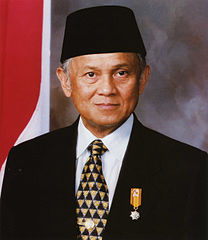Jusuf Habibie
| ||
 Jusuf Habibie (1998) | ||
| Data i miejsce urodzenia | 25 czerwca 1936 Pare-Pare | |
| Data i miejsce śmierci | 11 września 2019 Dżakarta | |
| 3. prezydent Indonezji | ||
| Okres | od 21 maja 1998 do 20 października 1999 | |
| Poprzednik | Suharto | |
| Następca | Abdurrahman Wahid | |
 | ||
Bacharuddin Jusuf Habibie, Rudy Habibie, B.J. Habibie (ur. 25 czerwca 1936 w Pare-Pare, zm. 11 września 2019 w Dżakarcie[1][2]) – indonezyjski polityk, prezydent w latach 1998–1999.
Ukończył studia w dziedzinie inżynierii lotniczej, początkowo w Bandung, następnie w Akwizgranie (Niemcy), a w 1965 obronił doktorat i pracował w Messerschmitt-Bölkow-Blohm w Hamburgu. W latach 1978–1998 był ministrem technologii i badań naukowych w rządzie prezydenta Suharto. Jako bliski współpracownik Suharto, w marcu 1998 został mianowany wiceprezydentem Indonezji, a po rezygnacji Suharto został prezydentem kraju 21 maja 1998.
W październiku 1999 zamierzał kandydować na kolejną kadencję, ale ostatecznie wycofał się przed wyborami. Na urzędzie prezydenta zastąpił go Abdurrahman Wahid.
Przypisy
- ↑ Indonesia's third President B. J. Habibie dies at 83 (ang.). devdiscourse.com, 2019-09-11. [dostęp 2019-09-11]. [zarchiwizowane z tego adresu (2019-09-11)].
- ↑ Christine Manby: BJ Habibie: Indonesian leader whose short tenure was marked by a shift to greater democracy (ang.). independent.co.uk, 2019-10-10. [dostęp 2019-10-11]. [zarchiwizowane z tego adresu (2019-10-11)].
| ||||
Media użyte na tej stronie
State emblem of Indonesia is called Garuda Pancasila. The main part of the coat of arms is the golden mythical bird Garuda with a shield on its chest and a scroll gripped by its leg bears the national motto: "Bhinneka Tunggal Ika", roughly means "Unity in Diversity". The shield's five emblems represent Pancasila, the five principles of Indonesia's national philosophy. The numbers of feathers was meant to symbolize the date of Indonesian Proclamation of Independence; 17 feathers on each wings, 8 tail feathers, 19 upper tail feathers (under the shield, above the tail), and 45 neck feathers; all symbolize 17-8-1945; 17th August 1945. Garuda Pancasila was designed by Sultan Hamid II of Pontianak, and was adopted as national coat of arms on February 11, 1950.
Bacharuddin Jusuf Habibie, 7th Vice President of Indonesia
Signature of B. J. Habibie (3rd President of Indonesia).


